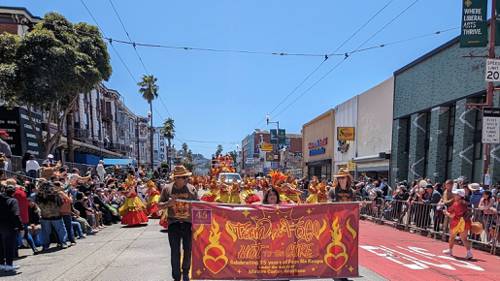
FAQ About The Influence of Afro-Latin Dance on Contemporary Choreography

What are Afro-Latin dance styles?
Afro-Latin dance styles are traditional dances that originate from the fusion of African, Latin American, and Caribbean cultures. Some popular Afro-Latin dances include salsa, rumba, merengue, bachata, and cumbia. These dances are characterized by rhythmic, energetic movements and often involve coordination with partners.

How has Afro-Latin dance influenced contemporary choreography?
Afro-Latin dance has influenced contemporary choreography by introducing rhythmic diversity and new movement vocabularies. Contemporary choreographers incorporate the fluidity, expressiveness, and cultural narratives inherent in Afro-Latin styles to create dynamic performances that resonate with global audiences. This fusion often results in innovative dance pieces that reflect a blend of traditional and modern elements.

What is the role of salsa in contemporary dance?
Salsa plays a significant role in contemporary dance by adding intricate footwork, lively partner interactions, and an infectious rhythm that enhances choreographic complexity. Contemporary dancers and choreographers use salsa movements to create engaging performances that offer a fresh interpretation of both salsa and modern dance genres.

How does rumba contribute to modern dance expression?
Rumba contributes to modern dance expression by emphasizing body isolation, sensuality, and a deep connection with rhythm and music. Its passionate and grounded movements provide choreographers with a rich vocabulary to express emotions and storytelling, thus enhancing the emotive power of contemporary performances.

What are some examples of Afro-Latin influences in contemporary choreography?
Examples of Afro-Latin influences in contemporary choreography include performances that integrate salsa's rapid, spinning motions, rumba's slow, articulate isolations, or the sensuous hip movements found in bachata or mambo. Artists such as Alvin Ailey have historically incorporated these elements to bring cultural depth and diversity to modern dance.

Why is cultural fusion important in contemporary dance?
Cultural fusion is important in contemporary dance because it allows for the blending of various traditional and modern forms, creating a rich tapestry of movement and expression. This fusion fosters creativity, innovation, and global understanding by celebrating diversity and common human experiences through dance.

Can Afro-Latin dance be adapted to solo contemporary performances?
Yes, Afro-Latin dance can be adapted to solo contemporary performances. The foundational movements and rhythmic patterns can be customized to suit individual expression, allowing dancers to explore personal interpretations and storytelling. Solo performances often highlight the dancer's connection with the music, showcasing technical proficiency and emotive depth.

How do choreographers incorporate Afro-Latin elements into their work?
Choreographers incorporate Afro-Latin elements into their work by blending traditional movement patterns with contemporary dance techniques. This can involve integrating Afro-Latin rhythms, using dance formations that reflect partner work, or infusing their pieces with cultural themes and narratives. The result is often a visually and emotionally engaging performance that bridges multiple dance traditions.

What are the challenges of integrating Afro-Latin dance into contemporary choreography?
The challenges of integrating Afro-Latin dance into contemporary choreography include maintaining the authenticity of traditional movements while innovating them within a modern context. Choreographers must balance cultural respect with creative exploration, ensuring that the fusion honors the roots and stories of the original dance styles without reducing them to mere aesthetic elements.

Are there notable contemporary choreographers known for using Afro-Latin dance?
Yes, several notable contemporary choreographers are known for using Afro-Latin dance elements in their work. Alvin Ailey, for instance, is renowned for his incorporation of cultural themes and dance styles into modern choreography. Other choreographers, such as Camille A. Brown and Ronald K. Brown, also draw on Afro-Latin influences to create culturally rich and dynamic performances.

How does Afro-Latin dance enrich contemporary dance performances?
Afro-Latin dance enriches contemporary dance performances by infusing them with vibrant energy, cultural depth, and rhythmic variety. It adds layers of storytelling through expressive movements and provides audiences with a visually stimulating experience that highlights the fusion of tradition and innovation in dance.

What are common misconceptions about Afro-Latin dance in contemporary contexts?
Common misconceptions about Afro-Latin dance in contemporary contexts include the belief that they are simplistic or purely entertainment-focused. In reality, these dances involve complex rhythms and deep cultural significance, contributing significantly to the expressive and narrative potential of contemporary choreography.

How does the rhythm of Afro-Latin dance impact contemporary choreography?
The rhythm of Afro-Latin dance impacts contemporary choreography by introducing complex beats and syncopated patterns. These rhythms require dancers to develop a precise musicality and timing, which in turn enhances the technical and creative aspects of contemporary dance compositions.

What techniques from Afro-Latin dance are commonly used in contemporary choreography?
Techniques from Afro-Latin dance commonly used in contemporary choreography include body isolations, quick footwork, partnering movements, and expressive gestures. These techniques are adapted to fit the thematic and aesthetic goals of modern dance, creating a unique hybrid form that appeals to diverse audiences.

How do Afro-Latin dance traditions influence contemporary dance globally?
Afro-Latin dance traditions influence contemporary dance globally by promoting cultural exchange and enriching global dance scenes with their diverse styles and music. This global influence encourages inclusivity, fosters innovation, and highlights the interconnectedness of world dances through shared artistic expression.

What role does improvisation play in Afro-Latin and contemporary dance?
Improvisation plays a significant role in both Afro-Latin and contemporary dance as it allows for individual creativity and personal expression. In Afro-Latin styles, improvisation often manifests in spontaneous partner interactions or within solo expressions of rhythm, while in contemporary dance, it serves as a tool for exploring new movements and ideas.

How have technological advancements affected the fusion of Afro-Latin and contemporary dance?
Technological advancements have affected the fusion of Afro-Latin and contemporary dance by providing new platforms for choreography and performance. Digital media allows for increased access to diverse dance forms, while sound and lighting technologies enable more dynamic and immersive performances. These tools help choreographers experiment and expand the reach of globally influenced dance styles.

What cultural narratives are conveyed through Afro-Latin dance in contemporary choreography?
Cultural narratives conveyed through Afro-Latin dance in contemporary choreography often revolve around themes of identity, heritage, and social change. Dancers and choreographers use these dance styles to tell stories that resonate with shared cultural memories and struggles, bringing to light the history and contributions of the Afro-Latin diaspora.

Can traditional Afro-Latin dance styles lose their identity in contemporary choreography?
There is a risk of traditional Afro-Latin dance styles losing their identity in contemporary choreography if the fusion does not respect or acknowledge the origins and cultural significance of the traditional movements. To prevent this, choreographers should strive to maintain the authenticity and context of the dances while exploring creative new directions.

How do dancers train to master both Afro-Latin and contemporary dance styles?
Dancers train to master both Afro-Latin and contemporary dance styles by engaging in rigorous practice that includes learning technical skills from both traditions. This often involves cross-training in diverse dance workshops, studying cultural histories, and participating in performances that highlight each style's unique demands and characteristics. This integrative approach helps dancers develop versatility and adaptability in their craft.
